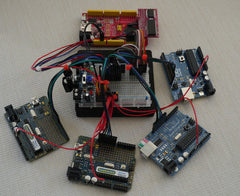Enthusiast Philip Stevens has recently published his efforts on modifying a cache RAM system used with Arduino boards to work with a range of Ardusat Arduino-compatible client nodes. Doing this allows each client to access a unique 32 kByte of XRAM as well as their own 2 kByte of internal SRAM. If the whole thing seems a little "over your head", don't worry as it's all explained in great detail.

It's a fascinating example of how Arduino boards can communicate with each other, and shows what's happening inside the ArduSat. So for more information visit Philip's interesting project website.
Have you heard about ArduSat? It's the first open-platform low Earth orbit satellite system that allows any member of the public to design and run their own space-based applications. The project was originally funded by KickStarter donors and is now progressing very well. Participants can create their own Arduino sketches to run inside the satellite, taking advantage of the on-board sensors to record results and generate data. The hardware contains the equivalent of sixteen Arduinos which can run up to around 12 sketches concurrently. Freetronics co-founder Jonathan Oxer gives us more details in the following video:
We're really proud to be part of the ArduSat vision of allowing anyone to run their own experiments in space, so as well as being the payload hardware partner - we also have ArduSat prototyping modules for sale that allow you to recreate your own hardware for testing before uploading the sketch to the ArduSat system, or for your own projects. For more information about the ArduSat, visittheir website.










